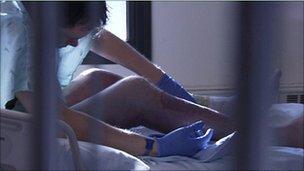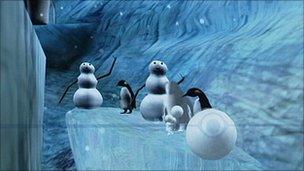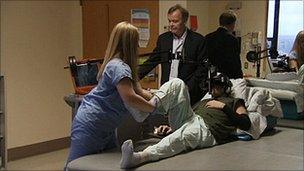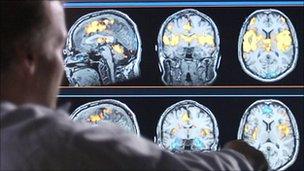Easing pain for burns victims using virtual reality
- Published
- comments
Burn patients in the US are being helped to escape the pain of burn injuries by immersing them in the virtual reality of a computer game during treatment.
Agony from severe burns can be one of the most intense and prolonged types of pain you can experience. And for many, the rehabilitation treatment is as painful as the initial burn.
Caleb Springer, aged 23, from Valdez in Alaska suffered second and third degree burns when he was set on fire in a motorbike accident.
Petrol spilled out of his scooter and a stray cigarette spark ignited it.
"I was engulfed in flames for probably two minutes. It was the worst pain I've ever felt, it was just excruciating. I looked down and just saw skin hanging from my legs," he said.
His burns were so bad he was airlifted from Alaska to a specialist centre in Seattle where his rehabilitation has been helped by pioneering treatment using a virtual reality computer game.
Escape from pain
SnowWorld, set in an icy 3D canyon, was developed by Professor Hunter Hoffman and Professor David Patterson at the University of Washington Harborview Burn Centre in Seattle.
It evolved out of the scientific advances in the last decade in understanding pain.

Caleb has had skin grafted from his back to his arms and legs
The aim of the game is "to make a very attention grabbing experience for the patient and basically to give them a place to escape from their pain" says Professor Hoffman.
Scientists have found many different elements can affect how we experience pain, including our emotions, environment, context and distractions.
"Because pain has such a strong psychological component to it, psychological treatments can be used to counteract the pain," said Prof Hoffman.
"Because humans are so visually dominant wherever you're looking typically that's where your attention is focused.
"(For patients) during wound care, when they're getting their bandages changed, they're looking at these different tools that the nurses are using to treat them, and just looking at those objects makes them anxious.
"They begin to associate objects in the room with high pain so you can imagine that day after day they start to develop psychological associations between the treatment room and pain, amplifying how much pain they experience."
Another world

The virtual snowball fight with snowmen and penguins is more immersive than music or movies
Being immersed in SnowWorld puts a "curtain between the patient and reality", he explains.
Patients wear a helmet hooked up to the virtual world and wear noise cancelling headphones, cutting off all the sights and sounds associated with the painful treatment.
It is a fairly simple computer game. Patients can throw snowballs at various objects, including snowmen, igloos, mammoths, and penguins.
"When they put you in SnowWorld, the snowmen throw snowballs at you and you have to throw snowballs back at them," says Caleb Springer.
"If you hit the penguins, they freeze, and if you hit them a second time, they explode. There's a lot of action in it. You never stop to think about anything else."
The game is quite simple, intentionally, because patients could not concentrate on regular computer games.

Caleb played SnowWorld during physiotherapy
The icy world was chosen, so patients would not be reminded of the fire that caused their burns.
"When I was in SnowWorld, I didn't think about the pain at all. There was pretty much no pain - there were at some points, but the most part there was no pain," said Caleb.
There is a limit to how much information the brain processes at any one time, so although Caleb's brain received exactly the same amount of pain signals, he did not register them.
"They basically become oblivious to what's happening in the hospital room," explains Professor Hoffman.
"There are other studies showing you feel less pain during music or watching movies, but this takes it to a much more stronger level, because it's so immersive.
"It isolates the patient from the real world, unlike any other media that's ever been tried. That's part of the reason we're getting such strong results".
Over the last two years, Prof Hoffman has been collecting brain scans from his patients.

Prof Hoffman said there was a 50% difference in brain activity in patients who used the game
Pain-related brain activity "lights up their brains like a Christmas tree when there's no virtual reality".
"When you compare it to pain stimuli when they were in virtual reality, some regions showed a 50% reduction in brain activity.
"This is consistent with the idea that there is so much attention devoted to SnowWorld that there is not enough attention available to process the pain signals anymore."
A growing number of burn centres around the world are showing interest in using SnowWorld with their patients, including hospitals in New York, Hawaii, Copenhagen and Holland
Caleb and SnowWorld feature in Horizon: The Secret World of Pain on BBC Two 31 January 2100 GMT.